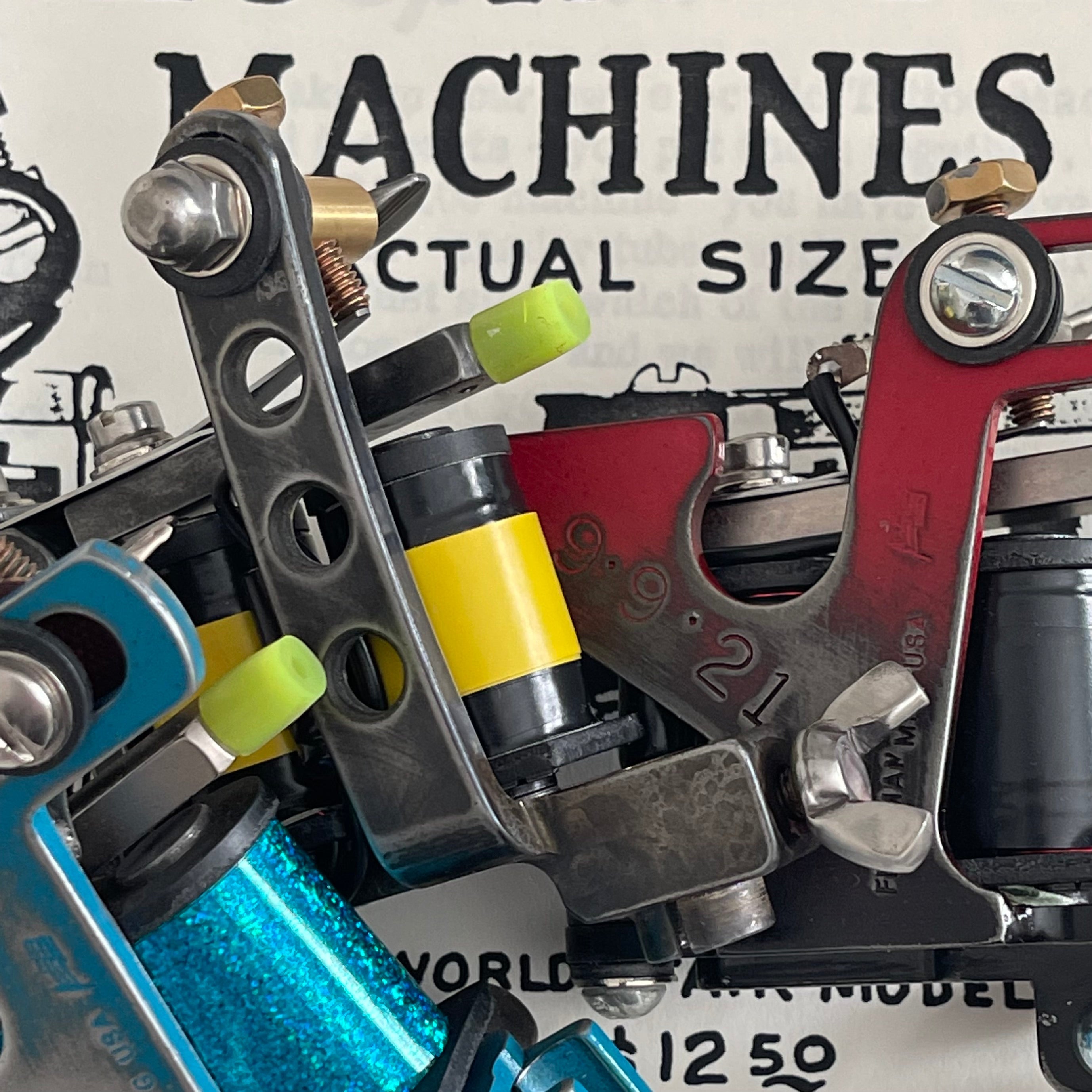
The Anatomy of a Coil Tattoo Machine
Posted on
The Anatomy of a Coil Tattoo Machine: Interview with Brandyn Feldman
Interview by Courtney Conley, Wife and Business Partner at Feldman Tool Co.
When it comes to tattoo machines, coil machines carry a legacy that’s impossible to ignore. They’re mechanical, responsive, and packed with power. But tattooing is about balance—knowing when to use the right tool for the job. At Feldman Tool Co., we build both coil and rotary machines with the same precision, durability, and control because serious tattooers know they need both.
To break down the anatomy of a coil tattoo machine and why it’s still an essential tool, I sat down with Brandyn Feldman—tattooer, machinist, and the mind behind Feldman Tool Co. (formerly Feldman Mfg.).
Let’s get into it.
What Is a Coil Tattoo Machine?
A coil tattoo machine is the hot rod of the tattoo world. It runs on electromagnetic coils that pull an armature bar down and let springs snap it back, creating that signature punch. It’s mechanical, tactile, and responsive.
Rotary tattoo machines, by contrast, run on a motor that moves the needle in a continuous motion—smooth, steady, and quiet. Both have their place, but coil machines provide direct feedback that many artists rely on.
“A well-tuned coil machine doesn’t just run—it hums. It vibrates like a heartbeat, letting you feel the work as you go. Rotary machines are great for long sessions and smooth shading, but coils? Coils are for artists who want that raw mechanical connection to their work.” — Brandyn Feldman
When to Use a Coil vs. Rotary Tattoo Machine
🔥 Coil Machines: Best for bold lines, color packing, and dynamic shading.
🔥 Rotary Machines: Ideal for smooth gradients, fine lines, and long tattoo sessions.
🔥 Why Have Both? Because the best artists use the right machine for the job.
At Feldman Tool Co., we build both—because professionals need options.
Breaking Down the Guts of a Coil Tattoo Machine
If you want to master your coil machine, you need to understand what makes it tick. Here’s the breakdown:
1. Frame
Holds everything together. The material makes a difference:
-
Aluminum: Lightweight, easier on the wrist.
-
Brass: Heavier, absorbs vibration, rock-solid feel.
-
Iron/Steel: Enhances magnetic conductivity for a smooth ride.
2. Coils
The electromagnetic core. Coil wraps affect performance:
-
6-wrap: Quick and snappy for fine linework.
-
8-wrap: The industry standard—balanced power for all-purpose tattooing.
-
10-wrap: Used when core materials were weaker, not common today.
-
12-wrap: Overkill unless you’re stuck using low-grade materials.
3. Armature Bar
The part that moves the needle. Its weight and balance dictate speed and impact.
4. Springs
Control speed and hit strength:
-
Front spring: Affects how the needle cycles.
-
Back spring: Controls tension and power.
5. Contact Screw
Regulates electrical flow and timing—keep it clean.
6. Capacitor
Stabilizes voltage for consistent performance. It stores and releases current for a smooth power flow.
7. Binding Posts & Clip Cord Connectors
Without these, your machine’s a paperweight. They keep the power flowing so your setup doesn’t cut out mid-line.
Tuning a Coil Tattoo Machine: Why It Matters
If you’re running a coil machine out of the box without adjustments, you’re leaving performance on the table. Every artist’s hand speed and technique are different—your machine should match yours.
“Tuning is everything. A properly tuned coil machine works with you, not against you. It’s the difference between a butter-smooth ride and a choppy, frustrating mess.” — Brandyn Feldman
Key Adjustments for Tuning:
🔧 Coil Alignment: Ensures a smooth magnetic pull.
🔧 Spring Tension: Adjusts speed and hit power.
🔧 Voltage Settings: Usually between 3.5V–8V, depending on your setup.
Pro Tip: Keep a log of your machine settings—needle groupings, voltage, and results. This helps you fine-tune over time.
Why Artists Need Both Coil & Rotary Machines
A good artist can work with any machine. A great artist knows when to switch between coil and rotary to get the best results.
“If you’re pulling bold, solid lines all day, a coil is the way to go. But if you’re shading for six hours straight? Grab a rotary. It’s about making your life easier while keeping your tattoos looking damn good.”— Brandyn Feldman
Why Artists Stick with Coils:
✔ Unmatched Customization – Fine-tune every hit.
✔ Power & Precision – Harder hits for solid saturation.
✔ Mechanical Connection – Feels like working on a classic car.
Why Adding a Rotary Makes Sense:
✔ Smoother Motion – Ideal for long shading sessions.
✔ Less Fatigue – Easier on the wrist for extended work.
✔ Quiet & Consistent – Great for fine detail and soft blends.
Final Thoughts: The Legacy of Feldman Mfg. & Feldman Tool Co.
Before Feldman Tool Co., Brandyn ran Feldman Mfg., one of the most respected coil machine brands in the game. The name may have changed, but the commitment to quality and the coil machine tradition remains.
If you’re still tattooing with only one type of machine, you’re limiting yourself. A well-rounded tattooer has both—coils for power and tradition, rotaries for precision and endurance.
🔥 Want to feel the difference? Check out Feldman Tool Co.’s latest coil and rotary tattoo machines—built by tattooers, for tattooers. 🔥
Contact
B@feldmantoolco.com
